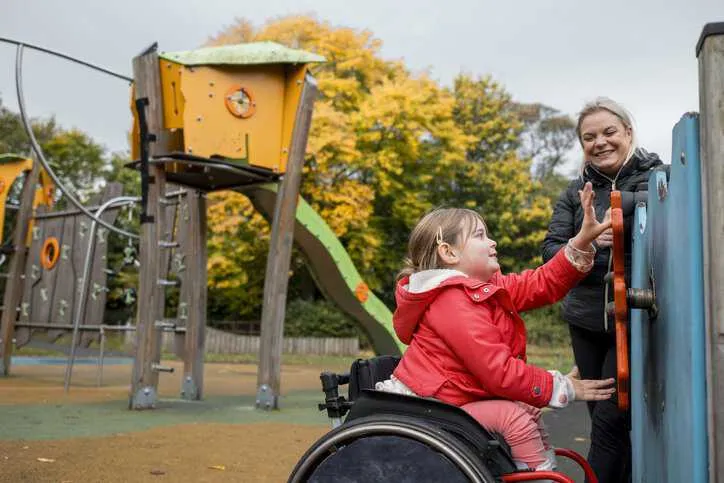ASTM F1951-21: Playground Accessibility Surfaces

The 7.3 million disabled students in the U.S. made up 15% of national public school enrollment during the 2021-22 school year. For children with and without disabilities, the community playground can facilitate a positive environment for physical activity and inclusion. As such, choosing accessible play surfaces is a critical decision during the playground planning and design phases. ASTM F1951-21: Standard Specification For Determination Of Accessibility Of Surface Systems Under And Around Playground Equipment provides a uniform means of objectively quantifying the performance and accessibility of different playground surfacing materials.
Importance of ADA Compliant Playground Surfaces
Inaccessible playground surfaces can pose barriers for children with disabilities who may use canes, crutches, walkers, or wheelchairs. Pushing a wheelchair over loose gravel or sand requires tremendous physical effort, and rubber tiles and bonded rubber surfacing can cause issues for wheelchair tires, since they can get stuck in the cracks between rubber tiles and the sponginess of bonded rubber can cause mobility issues. When so much effort is exerted, little to no energy is left for play. ASTM F1951-21 underscores the need to have playground surfaces that are firm and stable and, if within the use zone, resilient, enabling the use by people with mobility impairment.
What Is ASTM F1951?
ASTM F1951-21 applies to all types of materials that can be used as the accessible route through the play area, under, and around playground equipment. It establishes characteristics for factors including running slope, cross slope, openings in the surface, changes in level, pile height, firmness, and stability that determine the accessibility surfaces for playground equipment.
This standard also specifies a means to measure the work for a person with mobility impairment to traverse surface systems. ASTM F1951-21 details a wheelchair work test method to determine the work required to propel a test wheelchair or standard crutch tips on a reference surface and specified slope. Moreover, this specification establishes quantitative measurements for wheelchair work related to the firmness and stability of a surface material used as the accessible route in the playground.
Why Is Playground Equipment Popular?
Playground equipment helps build children’s sensory, cognitive, social, communicative and physical skills. Playgrounds should appeal to kids. As such, it is important to recognize what makes playground equipment popular among them:
- Design: Bright colors captivate children, helping stimulate and activate their mind
- Nature: Playground are often outdoors, immersing children in nature and helping expand their curiosity about wildlife and fauna
- Social: Kids can form friendships on the playground and play together
- Psychological Development: Playing with a group of kids helps each child understand cultural rules, social roles, verbal language, social norms and body language. Kids can also develop a shared system of symbols and cooperation skills through group games and challenges.
- Stimulates the Mind: Playground equipment enables kids to utilize their surroundings and establish obstacle courses
- Active: Plenty of playground components allow for playing in a larger group, such as climbing walls and monkey bars.
- Variety: A great playground will have separate, clearly defined areas for meeting the needs of specific age ranges as not every piece of equipment is suited for all age groups.
ASTM F1951-21: Standard Specification For Determination Of Accessibility Of Surface Systems Under And Around Playground Equipment is available on the ANSI Webstore






